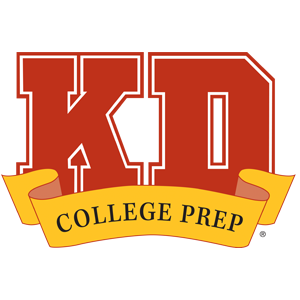The moment you’ve been waiting for is finally here: you’re applying to college. Now you may be wondering what the next steps are in the college application process.
There are many factors to consider: Where do you want to go? What do you want to study? Are your grades good enough to get into a good school? Will you be able to afford it if you do?
These and others are some of the questions you’re probably asking yourself at the beginning of this process—and getting the answers might prove unexpectedly difficult.
There are a lot of steps involved in applying to colleges and a lot of different information on how to approach it. Here are our ten steps for making the process as straightforward as possible.
10 Steps for Applying to College
Step 1: Career & Major Exploration
Deciding what you want to do with the rest of your life can seem like a nerve-wracking experience, but it needn’t be. Think back through high school so far: what got you the most excited? Maybe it was learning a new programming language or understanding a new math concept. Identify the things that you’re good at and imagine what kinds of careers to which you could apply these interests.
Think about where your priorities lie. Want to maximize your earning potential? Research the highest-paying majors and see if any stick out to you. Want to spend your career helping others? Maybe medicine or social work is right for you.
Also think about how rigorous the coursework in your selected major will be. Depending on the program, the time commitment required to do well academically can be a lot higher.
Still totally unsure of what you want to do? Meet with an academic advisor at your school to get an experienced opinion. Or take an aptitude test and review the results with a college counselor. Just remember: the decision you make now as a high school senior is not set in stone. College is a time for exploration. If you discover a new passion during your studies, you can always change your major.
Here are some quick tips for choosing a college major.
Step 2: College Planning
Colleges receive thousands of applications every year. The process of separating yourself from the pack begins early on in high school.
Colleges want to see that you’re challenging yourself as much as you can. Evaluate your schedule and sign up for as much as you think you’ll be able to handle.
They also want some indication of your interests outside of your school work. Clubs and extracurriculars are a great way to build soft skills.
In addition, keep in mind that test scores are another opportunity to stand out academically. It’s a good idea to give a college as many data points as possible that showcase your potential. Many colleges have adopted a test optional admissions policy, but the vast majority of schools will review your test scores if you submit them. If you’re not ranking at the top of your class because you attend a really competitive high school or because you have one bad grade weighing you down, remember that test scores are another way for you to shine. Many colleges also still tend to rely on test scores for scholarship consideration and honors college placement.
Lastly, be sure to take advantage of the test prep programs offered at KD College Prep. A great test score on the ACT®, SAT®, or PSAT tests could cast your application in a better light and expand your options.
Step 3: College Search
Once you’ve picked your major, the next step is to find colleges that offer this degree program and see which ones best meet your needs.
If you can, try to visit as many of the colleges on your list as possible. While the academic programs themselves are obviously important, you’re also making a decision about where you’re going to live for at least the next four years. You’ll want to be sure that the city you’re moving to is somewhere you’ll be able to enjoy living.
When building a college list, it’s important to fill it with a variety of options. Only applying to highly-competitive schools with low acceptance rates runs the risk of missing out on a potentially good fit. Build a balanced college list by separating college options into these three categories:
- Reach Schools – dream schools that you’d like to attend but may not get accepted into due to high competition or because your academic or personal profile is below what is typically accepted
- Match Schools – schools that tick a lot of the boxes but don’t quite qualify as a dream school
- Likely Schools – schools whose requirements you comfortably meet and you can picture yourself attending
Don’t wait until the last minute to build your list. Dedicate time to researching your college options. Attend college info sessions or fairs when possible, either in person or virtually. If you take the time to really learn about the schools on your college list early on in the process, you’ll feel more prepared and confident when applying.
Step 4: Choosing Deadlines
Early Action deadlines (EA) gives you an option to apply early. EA deadlines are great for students who have their applications prepared early, as it demonstrates interest to college admissions officers. EA deadlines start at the beginning of November and mean that you could potentially be celebrating an acceptance before the end of the calendar year. Some schools also offer EA II deadlines, which is another round of Early Action before regular deadlines hit. These decisions are non-binding, meaning that if a college accepts you through an EA deadline you don’t have to go there.
Single Choice or Restrictive Early Action is basically the same as Early Action, except that you can only apply to one school this way. This shows schools that they are your top choice. These decisions are also non-binding.
Early Decision deadlines allow students to apply early as well, but if the school accepts them then they have to go there. Early Decision deadlines are usually in November with acceptance decisions in December. You should only apply to Early Decision deadlines if you’re 100% sure that you want to go to that school.
Regular Decision is the most common type of college application deadline with due dates ranging from December to March and college decisions in late April. It’s non-binding. It’s the route that most people take with their applications, and an abundance of colleges only offer this choice.
Rolling Admissions means that there isn’t a hard deadline for applications. Colleges that use rolling admissions accept applications until all of their available spots are filled.
If you’re not sure of the specific application deadlines for the schools you’re applying to, remember to contact their admissions department for answers.
Step 5: Create a Resume
While good test scores will get your foot in the door, a resume is where you can begin to differentiate yourself from other applicants.
As mentioned earlier, taking as many challenging classes as possible in high school will provide deeper context for your GPA. Schools want to see that you’re not afraid of hard work and that you’ll take advantage of learning opportunities placed in front of you. While your academic performance will be detailed in your transcript, the resume allows you to call attention to a stellar GPA and other academic achievements such as awards, honor roll placement, or National Merit® recognition.
Adding other, non-academic entries on your resume will help set you apart as well. Colleges also want to know that you’ll be an active member of the student body. Participating in extracurriculars demonstrates your dedication, specific passions, and engagement with your local community. Being club president or serving as the captain of your sports team can also demonstrate leadership skills.
The resume is also a great place to mention your first job. Gaining professional experience, either through a part-time job or an internship related to your chosen major, gives you hands-on experience in professional setting, demonstrating your work ethic to schools.
Start by following this quick guide to building a college resume.
Step 6: Writing Essays
After taking care of the academics and outlining your achievements on a resume, writing admissions essays is perhaps one of the most effective ways of demonstrating what kind of student – and what kind of person – you are to the colleges on your list.
Admissions committees read thousands of essays every year, which means it’s crucial that your writing captures their attention while also giving them a good idea of who you are as a person.
Colleges review a lot of data points about you. They see your test scores, transcript, GPA, etc., but those pieces of the application don’t really show college admissions officers who you are on a personal level. That’s where the essays come into play.
But where do you begin? College essay writing is an art, and you can be creative when choosing a topic. Specific guidelines vary depending on the student and the college to which he or she applies, but the main idea is to give the school a better understanding of who you are and to do so in a creative and memorable way.
To give yourself the best chance of accomplishing this, be sure to give yourself plenty of time to write and review. It will probably take a few rough drafts until you find a topic you like, then another few to get the words right. If you want to get a good head start on your essays and learn to avoid common pitfalls in admission essay writing, our Apply Now! Boot Camp may be right for you.
Here are some quick tips for how to write a college admissions essay.
Step 7: Filling Out Applications
Once you’ve selected your target schools, it’s time to sit down and fill out the applications. As with many other parts of the process, the many different requirements of individual colleges can seem daunting. Luckily, the process is fairly standardized across schools throughout the country.
Here are the basic requirements that most colleges will ask for:
- Application – Fill out a basic application that provides personal information.
Financial information – Provide information about your family’s financial situation. This information helps colleges decide what kinds of scholarships they’ll offer you should you be accepted. - Standardized Test scores – Include your scores from the SAT, ACT, or both. Since the COVID-19 pandemic began, many schools have switched to “test optional,” allowing students to apply without submitting scores. However, if you have the kinds of scores the school is looking for, it’s better to include them. Most colleges will still take test scores into consideration if you submit them.
- Academic Transcripts – Provide schools with an official record of all your academic work so far, giving them proof of the difficulty and results of your coursework.
- Personal Statements and Supplemental Essays – Write essays that give schools a better idea of who you are as a person and why you chose to apply.
- Letters of Recommendation – Provide two or three letters from trusted adults in your life, such as teachers, coaches, or employers.
Many schools use the Common Application, or Common App, to make the application process easier. Applying to schools through the Common App—which reports having nearly 900 member colleges—allows you to use a single personal statement for multiple schools, drastically cutting down on the amount of time you spend per application. Many schools require additional essays on top of the personal statements, which is all the more reason to have a thorough list of schools and their individual requirements before getting started.
Step 8: Financial Aid
College is expensive, but luckily there are many avenues for financial assistance.
Every student, regardless of family income, should apply to the Free Application for Federal Student Aid, or FAFSA, which opens on October 1st of every year. Your FAFSA application will calculate your expected family contribution towards tuition, which schools will use to determine how much aid they offer you through things like grants and scholarships.
FAFSA also determines the amount of Federal Loans that you qualify for. Loans that come directly from the U.S. Department of Education typically have a lower interest rate than private student loans.
For more information about filling out the FAFSA, read our financial aid guide or visit StudentAid.gov.
Step 9: Scholarships
In addition to the Financial Aid offered by the Federal Government and colleges, scholarships provide additional ways to help pay for some or all of your college expenses. These scholarships can come from a variety of places.
Some school districts offer scholarships or awards for students who meet certain academic criteria or participate in extracurriculars, such as members of sports teams or clubs. Though some of these local scholarships require an essay in addition to the application, many only require an application and answers to a few short-answer responses.
The colleges you’re applying to will also offer scholarships. Some will require specific test scores or class ranks in order to qualify. Most will also offer scholarships specific to your major or distinguishing characteristics, such as possessing leadership skills or coming from a specific or disadvantaged socioeconomic background.
Also, many private companies offer a variety of scholarships. Large corporations like Google or Coca-Cola offer highly-publicized scholarships, but keep in mind that the competition for such prizes is high. Instead, you may find local businesses or community groups with more attainable, albeit less lucrative, prizes. And don’t forget to ask your parents if their employers offer any special scholarships for children of employees.
Start searching using one of these free scholarship search tools listed below:
10 Online Scholarship Search Tools
- Sallie Mae Scholarship Search
- Scholly
- Scholarships.com
- College Board Scholarship Search
- Fastweb
- Cappex
- Niche
- CareerOneStop by the U.S. Department of Labor
- Raise.me
- Going Merry
Step 10: Making a Final Decision
Once you’ve been accepted to schools, the last step is deciding which option is the best one for you. This is ultimately a decision that only you can make. Once again, identify your priorities.
Which school will best serve your career interests? Is it the same school that’s offering you the most generous financial aid package? Is it the one in the town that impressed you the most on your campus visit? Talk to students and alumni of the schools that accept you and learn all you can about key programs and on-campus activities.
Wait for final word from all of the schools you applied to before making a final decision. If one of your dream schools waitlists you, there’s still a chance that you’ll be accepted. The same goes for deferrals, which happen when a college wants more information about a student—such as senior year grades or test scores—before making an admission decision.
When should I start my college applications?
As we’ve explained, the college application process involves a lot more than just filling out a form. Some aspects may take some time to complete, so it’s best to start as early as you can, but most students shift their focus to applications the summer before senior year.
For more tips on how to build your application timeline, read “When Is the Best Time to Apply to College?”
Is the college application process hard?
There are a lot of moving parts in the college application process, but taking proactive steps to prepare for it will make it much less difficult. Allow yourself plenty of time to gather information about the colleges to which you want to apply and their specific application requirements.
For additional, experienced help with every step of the process, consider taking advantage of KD’s college counseling services.
How long does it take for a college to accept or reject you?
Decision times vary widely by school. They can be affected by which kind of deadline you applied through and the decisions of other students. Try to connect with other applicants on social media—people posting about decisions they’ve received will give you a better idea of when to expect your own.
What are the requirements for a college application?
This also varies by school, but they will generally be similar across the board. Check for specific requirements on each school’s website.
What can I do to increase my chances of getting into college?
As you’ve seen, there are lots of steps involved in applying to schools. But if you’re reading this, you’re already on the right track! Having a plan in place ahead of time will make the process much less confusing, allowing you to focus on making your application as attractive as possible to the schools on your list.
At the end of the day, the best way to increase your chances of getting into college is to work as hard as you can in high school. Challenge yourself by taking difficult classes and asking for help from your teachers when you get stuck. Take an interest the world around you to find your passion and build relationships with your peers.
And if you want all the help you can get, take advantage of everything we have to offer for test prep and college counseling programs at KD College Prep.































